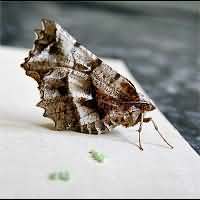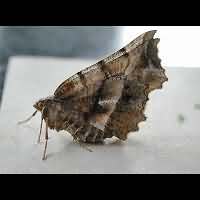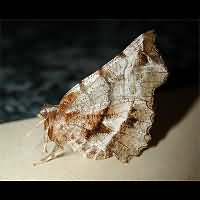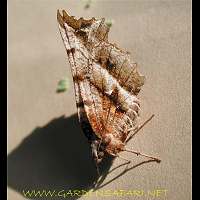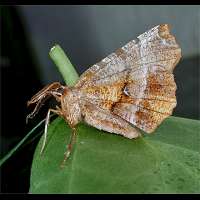Early Thorn (Selenia dentaria)
Being adult Thorns and allies do not look like other Geometers very much. The side of the wings is often very dented, they have a rather big body and the wings are never hold flat against the surface. In stead they are kept half or fully upright, the same way butterflies usually keep their wings. Most of the time the Early Thorn keeps his wings fully upright. This prevents you from seeing the darkened tops of the wing, a good characteristic for this species. For in the Early thorn the darkening gradually ends, in the similar Purple Thorn the darkening ends abruptly. The Purple Thorn usually sits in another posture: wings half opened and curled. In almost all cases the resting posture is sufficient to tell these two species apart. The Early Thorn is a rather big moth. However the specimens on the wing in spring are more colourful and much larger (wingspan up to 52 mm) than the specimens flying about in summer (wingspan up to 44 mm only).
The caterpillar, a typical Geometer Worm, is light brown with dark brown and greyish markings. The third pair of legs is swollen and on the back are two bumps. These together with the colour and markings make the caterpillar of the Early Thorn look just like a little twig, including buds. If the animal stretches its body and doesn't move it is very hard to spot indeed! Some thick, short hairs also contribute to this illusion. Because the moth is rather big, the caterpillar is too. It may reach a length of some 4 cm. The caterpillars of the summer generation are usually seen in June and July. They remain smaller than the caterpillars of the next generation. These appear from August onwards. Both generations feed on a great number of trees and shrubs, including sallow, birch, honeysuckle, alder and hazel. In October the caterpillars spin together a few leaves and pupate between them. The pupa falls to the ground with the leaves in autumn and overwinters.
The first brood is on the wing in May and June, the second in August and September, but the two generations may be overlapping. In Northern Britain the Early Thorn is single brooded, on the wing in May and June. It starts flying in early dusk. Despite its size, hardly ever seen resting during the day. Comes to light eagerly, even to slightly lit windows. A common species all over the British Isles, including the Inner Hebrides and Orkney. Very common in other parts of Europe too. In southern Europe sometimes a third brood occurs. One of the easiest species to keep in captivity.
The animals depicted here all belong to the first generation, except for the one in the bottom picture, which is much smaller and belongs to the summer generation.
Being adult Thorns and allies do not look like other Geometers very much. The side of the wings is often very dented, they have a rather big body and the wings are never hold flat against the surface. In stead they are kept half or fully upright, the same way butterflies usually keep their wings. Most of the time the Early Thorn keeps his wings fully upright. This prevents you from seeing the darkened tops of the wing, a good characteristic for this species. For in the Early thorn the darkening gradually ends, in the similar Purple Thorn the darkening ends abruptly. The Purple Thorn usually sits in another posture: wings half opened and curled. In almost all cases the resting posture is sufficient to tell these two species apart. The Early Thorn is a rather big moth. However the specimens on the wing in spring are more colourful and much larger (wingspan up to 52 mm) than the specimens flying about in summer (wingspan up to 44 mm only).
The caterpillar, a typical Geometer Worm, is light brown with dark brown and greyish markings. The third pair of legs is swollen and on the back are two bumps. These together with the colour and markings make the caterpillar of the Early Thorn look just like a little twig, including buds. If the animal stretches its body and doesn't move it is very hard to spot indeed! Some thick, short hairs also contribute to this illusion. Because the moth is rather big, the caterpillar is too. It may reach a length of some 4 cm. The caterpillars of the summer generation are usually seen in June and July. They remain smaller than the caterpillars of the next generation. These appear from August onwards. Both generations feed on a great number of trees and shrubs, including sallow, birch, honeysuckle, alder and hazel. In October the caterpillars spin together a few leaves and pupate between them. The pupa falls to the ground with the leaves in autumn and overwinters.
The first brood is on the wing in May and June, the second in August and September, but the two generations may be overlapping. In Northern Britain the Early Thorn is single brooded, on the wing in May and June. It starts flying in early dusk. Despite its size, hardly ever seen resting during the day. Comes to light eagerly, even to slightly lit windows. A common species all over the British Isles, including the Inner Hebrides and Orkney. Very common in other parts of Europe too. In southern Europe sometimes a third brood occurs. One of the easiest species to keep in captivity.
The animals depicted here all belong to the first generation, except for the one in the bottom picture, which is much smaller and belongs to the summer generation.

